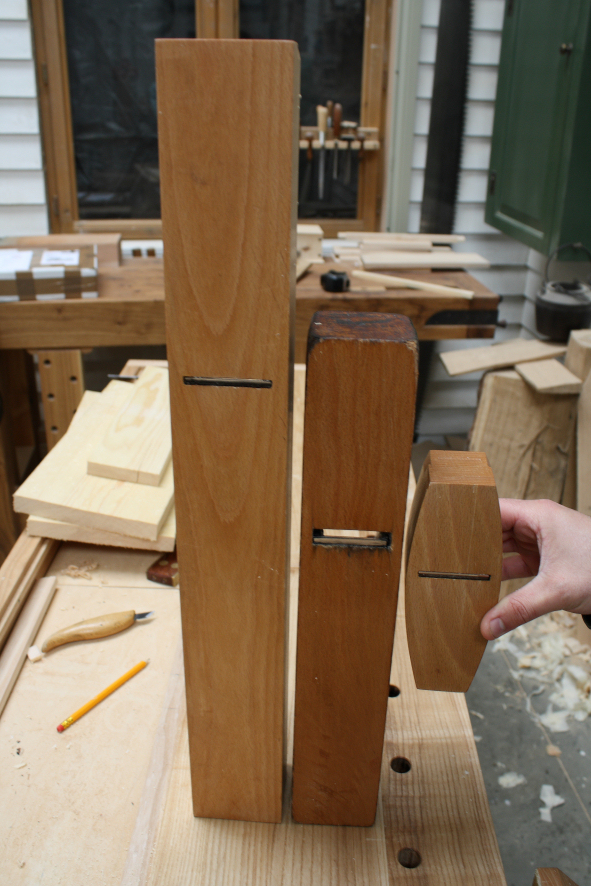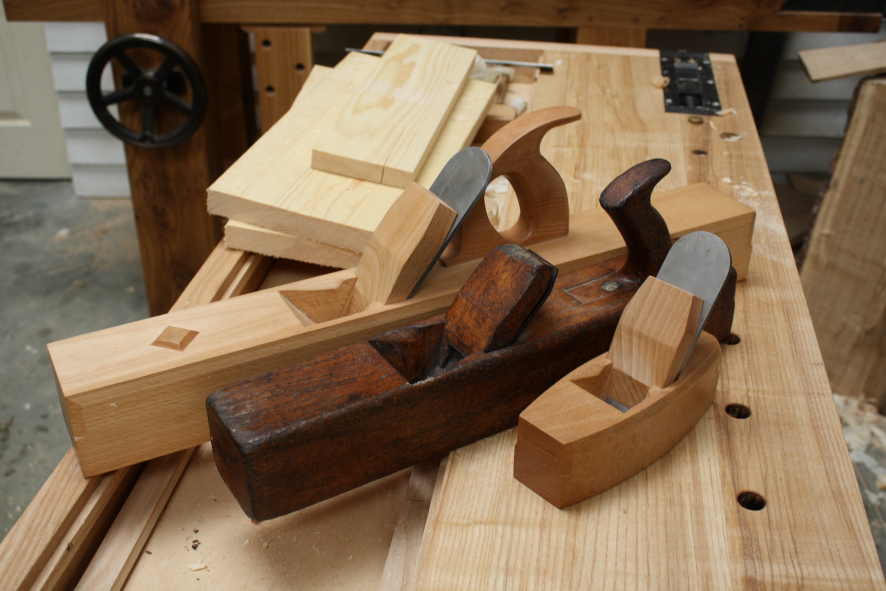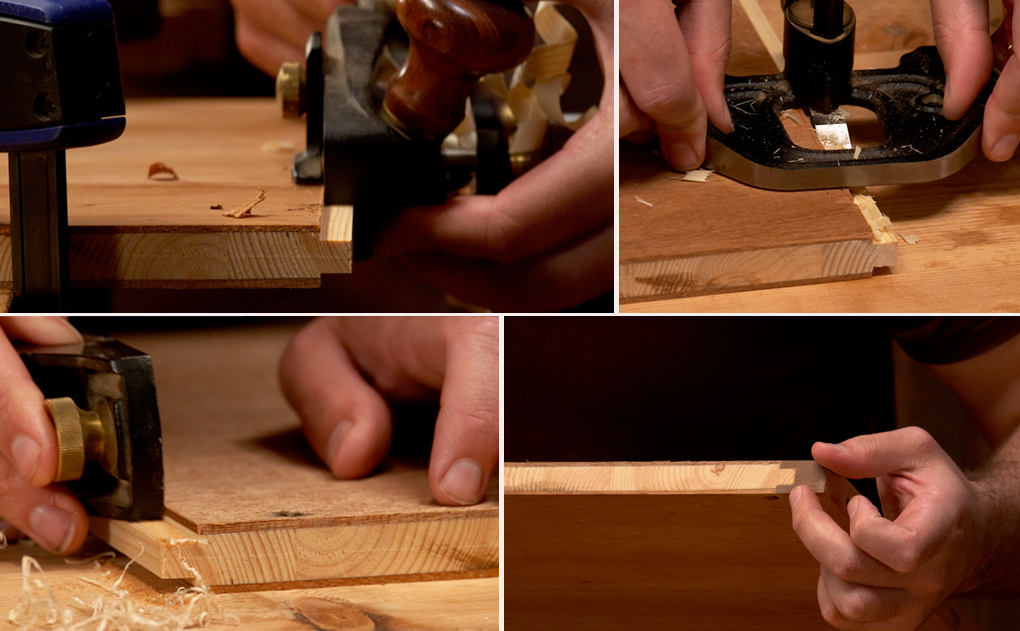Wooden Hand Planes Might Be Old Tech, But They’re Not Outdated
I think for many people wooden planes bring nostalgia and a nice sense of tradition but don’t necessarily seem relevant to use today.
We get used to a very different tool with metal planes, especially with some of the highly developed options now available, and so the techniques needed to set up, adjust and use them become further apart.
I use a mix of metal and wooden planes, and perhaps surprisingly it’s the wooden planes that I favour when I have a heap of boards to work, as their lighter weight is much less tiring. They’re always comfortable to hold and no one can deny the dreamy sound that they make as they glide across the wood, there’s none of that awful squeaking of a metal planes sole when it hasn’t had enough wax.
Using Wooden Hand Planes
For general board preparation I only have three wooden planes that I use all of the time.
It’s not a grand collection, but it’s all I need to take a rough board and make it flat and smooth. They’re certainly as quick as any metal alternatives, and my wooden smoothing plane can take on anything a metal plane can, leaving a far superior finish.
If you like the romantic appeal of a wooden hand plane but never thought them to be all that practical then don’t be too quick to dismiss them.
If your used to working with metal ones then there’ll be a few things that seem more complex and difficult, and I’m not going to deny there’s quite a heavy learning curve. But like most things if you persevere then all of a sudden it will ’click’. It’s not an easy thing to be taught as its more a case of getting the feel, but with a bit of patience you’ll soon start to appreciate to joy of using them.
To Learn How To Adjust Wooden Planes & Set The Iron Without Frustration, Then Have A Read Here.

The Different Types Of Wooden Planes: The long try plane for straightening. The jack or fore plane for rough, heavy material removal – note the wide open mouth for allowing the thick shavings through. The short coffin smoother with tight mouth to keep control of tear out.
Buying Old, Second Hand Wooden Planes
If you’re keen to give it a go without spending a fortune, then I’d still avoid the temptation of buying an old smoother from a car boot sale. They’re small and you should be able to pick one up extremely cheaply, but these planes are used for the final finishing work – they need to be set very finely to give good results, and trying to set up something rough and worn without any experience could quickly put you off wooden planes altogether.
Instead opt for something like an old fore plane, to start. These can be set for a range of heavy or fine work and will be much more forgiving when you’re starting out. My fore plane (a real rough jack) looks like its been chewed on by a pack of dogs, and the iron doesn’t really match the bed, but it works great as a roughing tool and I’ll never part from it.
Buying New Wooden Planes
I’d always be happy to source an old jack for the rougher work, but if you want to treat yourself then I would say a new try plane would be the ideal one for starters.
You’ll be setting up for a medium to fine cut, with a medium camber on the iron so there‘s some challenge compared to the rougher fore or jack plane. This way you’ll easily build up the skills of setting up a wooden plane without having to be too precise, and once you’ve got the gist of it you’ll quickly be able to transfer you’re skills to the finer smoothing planes.
Once you’ve mastered it, a wooden plane is in a league of it’s own for simplicity, and with this comes efficiency – there’s no screw drivers every time I need to touch an iron up, just a quick clunk with a mallet.
For me wooden planes can never be outdated as I need to use them daily for my job, and I certainly know I couldn’t earn my living without them. There’s a lot to cover on them; I could fill a book on this subject so I’ll be bringing more about wooden planes soon.



![Which Saws Are Best For Ripping Thick Stuff? [Video]](https://www.theenglishwoodworker.com/wp-content/uploads/2022/12/what-hand-saw-is-best-for-thick-rip-cuts.jpg)
![How do I Sharpen a Router Plane? [Q & A Video]](https://www.theenglishwoodworker.com/wp-content/uploads/2022/11/how-to-sharpen-a-router-plane-video.jpg)
![Bench Top Edge Jointing [with Video]](https://www.theenglishwoodworker.com/wp-content/uploads/2022/10/bench-top-edge-jointing-video.jpg)

Thanks Richard, great post. I love wooden planes and as you say much less fuss in setting them up.
Funny enough I was looking on Philly’s site when you posted this. I’m thinking I need to save my pennies once again. I look forward to more posts on wooden planes in the future.
Once again great post buddy, keep them coming 😉
Ken
Thanks Ken, both my smoother and try plane are made by Philly and they’re great tools. I asked for traditional beech and rounded tops on the irons so they’re just my cup of tea!
HI Richard,
This is a journey that I am about to re-aquaint myself and renovate the old planes… As you have rightly stated there is something quite satisfying about using wooden planes. You have jogged my memory again!
With reference to the squeaks… I recall many years ago working at the bench, using both metal and wooden planes, we used to have a small ‘cushion’ rather like a pin cushion. It was usually made from a scrap of hardwood comprising a base board and cut sides to form a well. It measured about four inches in diameter and a couple of inches deep, octagonal or square I believe, was packed with waste cotton and a piece of material over that to hold the cotton in place. This was then soaked with a little linseed oil and left on the bench as part of the ‘furniture’
When the squeaking became a problem or plane seemed to ‘drag’, the sole of the plane was wiped over the pad in a backward direction. This helped to make the plane run a little easier over the timber being worked. Obviously the pad was not flooded with linseed but enough to just lubricate the sole of the plane only. I recall this being particularly useful when planing materials having high resin content.
Best regards,
Jeff G
Another great memory, I’ve never made anything specifically for lubricating my planes soles, instead I’ve always opted for a simple table candle which I ‘scribble’ on whenever needed. Your oiled cushion sounds like it would do a very thorough job!
I’ve never really got on with wooden planes but I think that’s because my hands are quite small so I find their bulky shape difficult to hold comfortably. Pity because I’ve tried out several of Philly’s planes at various shows and they work very well.
Hi Paul,
I’m looking into making some ‘Krenov’ style planes. You can make these any size or shape you like. You could start with a small one handed block plane using an iron from an old Stanley block plane. Shape it so it feels comfortable in ‘your’ hand. A search on Google for ‘Krenov planes’ will bring up a load of info. Or see if you can find a copy of David Finks book on making and using wooden planes. It’s a good book for understanding wooden planes in general, and making the Krenov’s in particular. I might be a little biased but I think it’s worth the effort. Good luck which ever way you go.
They’re certainly much bulkier! Mark makes a good suggestion with the ’Krenov’ style planes, I think a lot of people opt for a more ’elegant’ shape when they make their own. My hands are like spades so I’ve always been happy to stick with tradition!
I’ve actually used a genuine Krenov plane – Philly has one and let me have a go. They are deceptive. They look quite roughly made but are very tactile and fit the hand like a glove. And they work beautifully. Wish I’d bought one when Krenov was alive. Might have a go at making one sometime.
Thank you Richard.
It’s good to see someone singing the praises of the good old “woody”. I don’t think people should be afraid at having a go at restoring an old wooden bench plane. They have two great things going for them in that they were made out of top quality air dried stock, and usualy have an iron that’s good old fashioned laminated Sheffield steel. The other thing is there so cheap to buy. the tool dealers can hardly give them away!
It always surprised at how many are up for grabs, they were definitely common at one time!
I’m in a similar place myself. I have a couple of Clifton planes,they are realy nice, but I hardly ever use them these days. The trouble was they were just too nice, I didn’t want to beat them up roughing out especially on the re-claimed timber I favour. So longstory short(ish).
I bought an old battered 14″ wooden jack. Put an insert in to close the mouth down a bit and trued the sole. Put a gentle curve on the iron and started to practice. Then came a second iron honed straight for jointing. Then a smooth plane (or two). Finally (so far) a monster 24″ long jointer, it can take shavings so thick you can use to make baskets or soft enough to wipe your ????.
Am I into wooden planes? You bet.
I love the sound of your battered old jack, is it in as good a condition as my fore plane 😉 What can be more satisfying than making beautiful things with battered old tools.. And your own ar** wipes?
Richard, if it wasn’t for the missing patch in front of the mouth, I’d have thought you’d nicked mine! 🙂
I’m in the process of turning some old wall studs from our recent bathroom remodel into a jewelers bench for our daughter. So battered old fart using battered old tools to turn battered old wood into something useful. My grandad would be proud of me. That man would never throw anything out, ‘if you can’t use it to make or repair something you can alwways light the fire with it’ was his moto. Where do you think I got the ’tissue’ idea from.
BTW. must say how much I enjoy the posts from Helen and yourself. I like things that either teach me something or make me laugh, you usually do both, well done.
They’re the best kinds of projects! I made my workshop cupboard from a old pallet (it’s the one painted green & seen in some of our photos), it’s certainly not my finest work but definitely one of the most satisfying.
Thanks for your kind words, it means a lot 🙂
I plan on buying a wooden coffin smoother one of these days.
Sounds like a nice treat, do you use wooden planes often?
Richard,
At the moment all my planes are metal, it’s just where i’ve started from and you get used to what you know, however i do have a very very small detail plane, probably used in model making, it was in a bulk load of other tools that were passed onto me. I recently did this little wooden plane up a little and sharpened the blade. Of course it isn’t going to flatten any boards being so small but it’s still cherished and used on very small pieces….it works a treat.
There is something so integral to our love for this craft when using any wooden tool, but perhaps especially the plane…i must get a larger one soon…..thanks for the post Richard, always a great boost in these dark and cold months.
Cheers
Steve
Richard
I am not a complete convert, having made a couple of infills and refurbed/rebladed several older Record and Stanleys which now give very satisfactory performance with gossamer shavings. As I dislike noise and dust, I have convinced myself that I can obtain a finer finished surface off a plane blade which better than any amount of sanding, hand or mechanical. Something to do with the cut surface reflecting light better than a sanded surface which seems somehow duller?
Partly inspired by David Barron’s articles, I have recently made a couple of Japanese “dai” type planes, one with a cut down blade in a sapele body, without a chipbreaker, and the other with a Herring blade and chipbreaker in an oak block.
Neither have the tightest mouth, but when I eventually get the blade adjustment right, they both perform superbly well, and, as all woody anthuisiasts know, the wooden body polishes the surface to a better finish than I can obtain with a metal plane. As a “not for profit” woodworker, the time spent was not a problem and the combination of a metal plane to get close to a final finish, and a final couple of strokes with the wooden plane to reach a final finished surface is my best solution so far.
I can thoroughly recommend this approach which although something of a ” bastard” compared with a full on Japanese plane, do not take long to make, and require very careful paring to properly bed the blade.
Regards
Mike
Yes, I concur. I’m still learning and have had a great time using very nicely tuned woo driver no5 of late, but for my rough work I always turn to a German jack that cost me all of a $1. For jointing I turn to my my mum’s old uncle’s Malloch try plane. A very nice handled coffin smoother was given to me by a friend a few year sago and it has become my favourite plane. Very tight mouth and incredibly thick blade. Not much of it left unfortunately so I will have to shop around for a new blade soon.
For those interested in new wooden planes check out those made by Terry Gordon here in Australiahttp://www.hntgordon.com.au/ . Made with a variety of timbers, thick blades and to a very fine finish. I have used a few and they are superb.
Cheerio,
Virg.
Hello Richard,
I’ve picked up some wooden planes (16-22″ in length) at a few antique auctions. Could you do a video on how to position the blade back in one after sharpening? For the life of me, I can’t get it configured so I’m taking a thin shaving–I either get nothing, or I’m hogging off a chip so thick I can’t push through it. With only two moving pieces, this shouldn’t be that tough to figure out, but I’ve tried and tried to get it right and just can’t.
Cheers,
Jordan
Please do let us know more about them. It would be very good to see you do a video on them as well. Love to hear someone talk about something they use everyday. It’s much better than some old collector or someone that never uses them.
HI Richard,
I have been following you on your comments about wooden planes. I am intrigue with the outstanding note about the use of these planes. I don’t have a lot of money and would like to acquire a couple of these planes, 41/2 or a 5 would be great as i use these quite often. Can you steer me in the right way to procure a couple used but workable planes. Icvan pay up to $50.00 per plane.
Thanks for you help, and ,no matter what you do I will still watch your articles.
Dan O’Neill
dano3690@comcast.net
Hi Dan, it isn’t difficult to pick up old wooden planes for a low price, they often come up at car boot sales, second hand tool shops and there’s nearly always something up for grabs on Ebay (though you may end up paying more for the postage than the tool). The best advice I feel I could give if you haven’t used wooden planes before would be to opt for a tool that is intended for rougher work. An old smoothing plane is likely to have a worn mouth and play in the iron fit so it would take a fair amount of work to get it working fine. An old fore plane on the other hand can still be of use despite being worn – adding a camber to the iron will also make it more forgiving when setting it up.
I recently did a very quick refurb on a shoulder plane and I’m sure you’ll be able to pick one of these up for a good price, there’s a post on it here: https://www.theenglishwoodworker.com/?p=1704
This is a good question and I’m sure I’ll come back to it in a post some time.
I use both metal and wood body planes. What about using a wood body plane for end grain? I have two low angle metal planes that I use for end grain, but wondered about the wood body planes, and how, if possible, to use them for end grain.
Keith, wood stocked planes work just fine on end grain. Low angle planes are not necessary. I regularly plane end grain with mine, and seldom use a metal plane. Just hold it up with a holdfast or lay it on a shooting board and plane it.